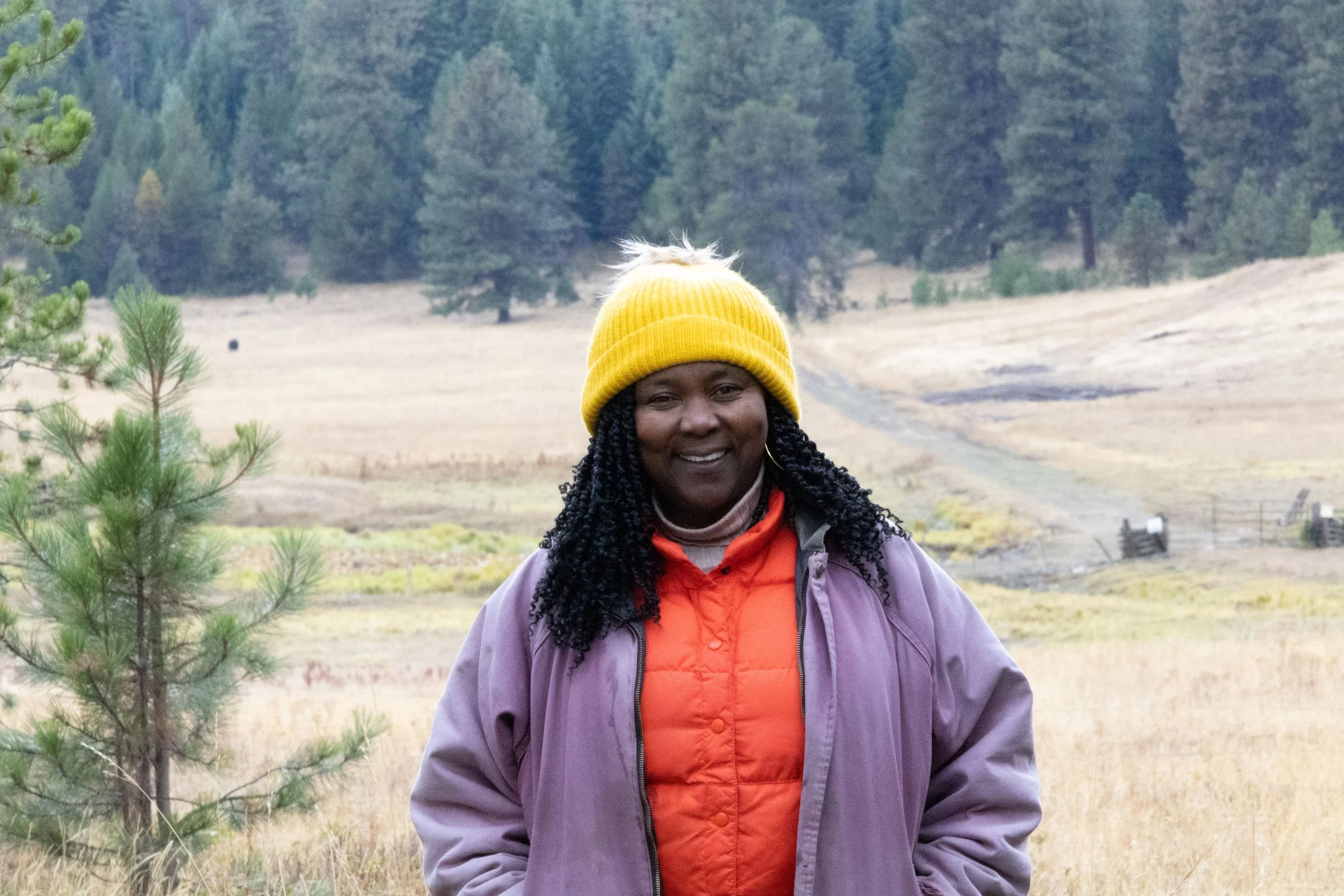Dawn at Maxville delivers serpentine trails of milky mist that graze over the vast field of cattle-trampled grasses like ghosts caught between earth and sky. Elk call out somewhere nearby as if they are scattered voices of an eerie, wailing choir. When the sun finally rises it’s easy for the mind to try and wander into the past, to reconstruct what is now out of sight. Gwen Trice is attempting to put this vision of re-creation into action. An hour's drive away from the abandoned town resides the Maxville Heritage Interpretive Center. With beige walls and light green trim it fits easily into the main street of Joseph Oregon. Unassuming, modest. But inside, two small rooms hold all the remaining stories and objects from a so-called “ghost town”. The project began with one woman, a curious daughter searching for answers and healing.
Gwen is the daughter of Lafayette “Lucky” Trice, a Black man who lived and worked in the Oregon logging town of Maxville, established in 1923 by Bowman-Hicks Lumber Company. Bowman-Hicks closed the town after just ten years. Gwen wasn’t alive during Maxville’s operations, but remembers growing up in La Grande, Oregon, and being told regularly that she wasn’t allowed to exist in White spaces and around White friends. She relives that pain telling us, “I hated me. I didn’t want to be me, and that’s probably the saddest thing that a child can come up with.” Throughout this period of self loathing, her father’s early adulthood was shrouded in some mystery for Gwen and when she learned of Maxville from her father late in his life as a community where White families and families of color lived and worked agreeably in close proximity, she held on tightly to the surge of hope for healing it gave her.
In order to fill in pieces of the story she didn’t get to hear from her father, she turned to others. In early 2009, Gwen released an episode of Oregon Experience through Oregon Public Broadcasting entitled “The Logger’s Daughter,” consisting of her interviews and research conducted in an effort to glue together the scattered shards of Maxville memories. A fifteen-years-younger Gwen Trice dresses in the same bright colors she does today and carries herself proudly with the same persistently bright smile alongside a slight concerned crease in her brow; the face of hopefulness alongside a shallowly buried and fervent frustration. She pours herself into interviews with, mostly White, still-living residents of Maxville, listening as they wax nostalgic about stories of her father, yet also occasionally drop a casual slur or two. Even as these sharp reminders of discrimination pass by, Gwen embraces these moments and expresses her appreciation for folks sharing with her their full, uncensored accounts of life in the logging town. Still, the shadow of active exclusion laws in 1920s Oregon looms, sometimes silently, over each conversation.
Equipped with hundreds of meaty stories and small bits of physical history, Gwen explains her intentions for this physical space and, in the process, creates something that conveys more than a Land Acknowledgement usually does. She says, “We are creating ways for people to understand the connection our space makes to the lands, to the Nez Perce tribe, the first peoples that were here before the land was stolen from them. And I like to consider it, consider us, temporary stewards of the land, because they had it for thousands of years and it was stolen. And we don’t know what could possibly happen in the future.” Gwen embraces this undefined future, never forgetting the ephemerality of her work; knowing that when the time comes, just like it did for Maxville a century ago, the land and the people will move on. But, as it often goes, memories, physical and intangible, will still linger.
On what once was the White side of Maxville shards of hotel ceramics lie, strewn atop the yellowed grass; highly visible. Remembered easily. Oil drums rest sideways, rusted razor edges of holes revealed through a century of weather. A few building footprints stand out somewhat obviously. But a half mile away, on the Black side of Maxville, the physical remnants of families are virtually invisible blanketed by thin layers of sediments and thick foliage. Here, some meticulous scraping of packed earth is in order. Where tiny makeshift railcar houses used to reside right next to the now absent tracks, a small team of archaeologists, employed by Gwen, kneel to dig and scrape and sift. Each millimeter of damp dirt removed reveals century old belongings of Black families suspended in fine sediments built up over decades and helps put together pieces of splintered stories.
The restoration of the Maxville Cabin is another significant step taken to carry out Gwen’s vision. Diligent work went into deconstruction of the remaining pieces of the weathered building, replacement of rotted and cracked wood, preservation of any still-useable material. Now, fine sawdust coats the floor and floats slowly in the sunbeams piercing through the original windows. Sunbeams pushing through the panes of glass just like they did one hundred years ago when Bowman-Hicks used it as their operations office, where Gwen’s father may have stepped inside, exhausted from hours of physical labor, to discuss a job with a colleague or a boss. Every once in a while, inside the cabin, Gwen pauses, tilting her head upwards with her eyes half closed in a silent moment of grief filled prayer; it loads the air with emotion and an unspoken understanding of simultaneous hurt and healing. The more Gwen reasserts the subjectiveness of trauma and the web of buried pasts, I am hopeful for how she will employ the character of the land, the unavoidable influence of its half-erased history, to soothe and move forward.
Gwen’s project in Maxville doesn’t exist to permanently develop the space into a Western fantasy land or a ghost town tourist site for casual romps and to supplement growing souvenir collections. Her vision doesn’t serve as a tool to quench a played out colonial thirst for voyeuristic fun, nor does it exist solely to subvert the exploitative history of archaeology. Instead, Gwen’s work shines an experimental light to the past in hopes of returned connection and community. In her words, “Now, I’m giving what I didn’t get, and it’s incredibly healing.”
At dinner one night, outside the cabin, Gwen declares with an almost frenetic delight her “Master Plan” for Maxville which includes a partnership with Dark Sky International, a bat identification sensor, and a 3D virtual recreation of missing buildings. Just then, somewhere in the distance, an elk lets out a haunting howl. Gwen pauses mid-sentence to close her eyes and face the sky just as she did in the cabin. And, maybe remembering that she’s allowed to take her time, she listens.




